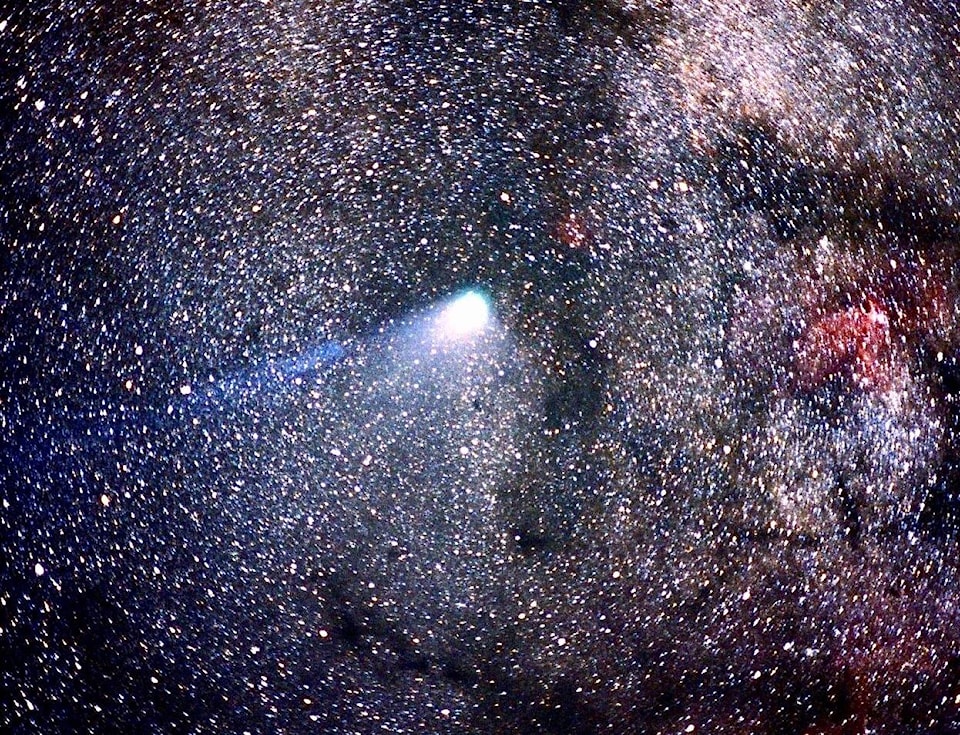By Samantha Bell
The Eta Aquariid meteor shower takes place from April 19 to May 28, and will peak the morning of May 6. Unfortunately, the meteors will have to compete against the light of the moon, which will drown out fainter meteors. For the best viewing, find a dark site and place yourself so that a tree or house blocks the moon. You will want to look east towards the constellation of Aquarius.
For those of us here in the northern hemisphere, we can expect to see about 10 meteors per hour, which is lower than the normal rate of 50. The best viewing will be in the southern hemisphere this year since Aquarius rises higher in the sky down there. This meteor shower, along with the Orionids in October, are caused by Earth crossing the debris left behind by Halley’s Comet (officially known as Comet 1P/Halley). Most of this debris is the size of dust or sand. When it enters our atmosphere, it produces the streaks of light we call meteors.
Venus now rises in the west shortly after sunset, reigning as the Evening “Star” all spring and summer. The planet will move eastward as the month progresses, arriving on May 13 between the horns of Taurus the Bull. On May 17, a crescent moon rests just to Venus’s left. Venus will end the month in the centre of the constellation of Gemini, the twins.
Jupiter will appear low in the southeast after sunset and climb rapidly in the night sky this month, reaching south around midnight, and southwest around dawn. On May 8, Jupiter will reach opposition — it will lie opposite the sun from our point of view here on Earth. This is the same day Jupiter will be at its closest approach to Earth for 2018. That means Jupiter will be at its brightest and biggest for the year on May 8, but because Jupiter changes slowly it will remain so for all of May. For viewing through binoculars or a telescope, the best time will be when the planet is high in the sky, to minimize atmospheric interference. Jupiter will remain in the constellation of Libra the Scales all month, but will appear to move slightly westward (this motion is called retrograde motion). The moon will be just to the northeast of Jupiter on May 27.
Saturn rises in the south around 1:30 a.m. at the beginning of May and slightly earlier each night until it is rising around 11:30 p.m. by the end of the month. The ringed world will spend May in the constellation of Sagittarius the Archer, moving slightly westward throughout the month. Saturn will be the brightest object in this constellation — just look for a yellowish “star” that is brighter than the surrounding stars but dimmer than Venus, Jupiter or Mars. Saturn’s famous rings are currently tilted at 26 degrees to Earth, making them easier to view. Like Jupiter, Saturn doesn’t change much this month when viewed through a telescope, giving you all May to take a look.
Mars will start May by rising in the south around 2 a.m., but being closer to us it will appear to move faster than the gas giants above. The appearance of the red world will improve as it approaches Earth, brightening and growing in size as it prepares for its closest approach in 15 years, which will take place in July. Mars starts May in Sagittarius and moves eastward quickly, passing into Capricorn by mid-month. It will have climbed the highest in the south-southeast just before morning twilight, which is the best time to take a look through a telescope. On May 6, the moon and Mars will appear close together, closer than any of the other planet/moon events mentioned in this column before. They will be close enough together that you should be able to fit both in one binocular field of view. Mars will be easy to find. Look for the bright reddish-orange “star” in the south that moves eastward during the night.
Neptune rises in the east at the break of dawn at the beginning of the month, but will rise earlier each night. It resides in the constellation of Aquarius and should be an easy binocular target.
Uranus is lost in the glare of morning twilight up here in the north until dawn in early June.
Mercury remains too close to the sun to observe in May, but will re-emerge at the end of June.
For those of you hunting the Dwarf Planet Ceres it starts May off just to the north of Cancer the Crab and will move in a straight southeastern line, passing through the bottom of Leo the Lion. Ceres will be easiest to spot when it is in Leo from mid-month on. If you are uncertain if you have spotted this dwarf planet, just do a quick sketch of the stars on a piece of paper and look again a couple nights later. One of the “stars” will have moved compared to the others. That will be Ceres, which is the largest object in the asteroid belt between Mars and Jupiter.
